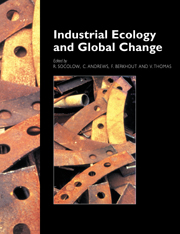Book contents
- Frontmatter
- Contents
- Foreword
- Preface
- Acknowledgments
- Contributors
- OVERVIEW
- PART 1 VULNERABILITY AND ADAPTATION
- PART 2 THE GRAND CYCLES: DISRUPTION AND REPAIR
- PART 3 TOXICS AND THE ENVIRONMENT
- PART 4 INDUSTRIAL ECOLOGY IN FIRMS
- PART 5 INDUSTRIAL ECOLOGY IN POLICY-MAKING
- END PIECE
- Organizing Committee Members
- Working Groups
- Index
Preface
Published online by Cambridge University Press: 04 August 2010
- Frontmatter
- Contents
- Foreword
- Preface
- Acknowledgments
- Contributors
- OVERVIEW
- PART 1 VULNERABILITY AND ADAPTATION
- PART 2 THE GRAND CYCLES: DISRUPTION AND REPAIR
- PART 3 TOXICS AND THE ENVIRONMENT
- PART 4 INDUSTRIAL ECOLOGY IN FIRMS
- PART 5 INDUSTRIAL ECOLOGY IN POLICY-MAKING
- END PIECE
- Organizing Committee Members
- Working Groups
- Index
Summary
A Novel Dialog
The 1992 Global Change Institute on Industrial Ecology and Global Change was held in Snowmass, Colorado, from July 19 to 31, 1992. Its principal written product is this book.
The institute was designed to encourage some of the first organized discussions between two communities: (1) natural scientists studying global change, and (2) a community that has focused on technological and policy responses to environmental constraints and on the underlying forces driving human activity. In the jargon of global change researchers, but probably nowhere else, this second community is called the “human dimensions” community.
The priority of the natural scientists studying global change is to understand the earth and its ecosystems—to get the science straight. For the past two decades these scientists have been knitting together previously independent disciplines, such as oceanography, atmospheric chemistry, and ecology, while consciously postponing reaching out beyond natural science.
During the same period, a human dimensions community has been forming, which takes as its starting point whatever current level of imperfect understanding of environmental science is available. This community has been trying to anticipate future levels of human impact on the environment—drawing on historical and economic studies of resource use in industry and agriculture, and on studies of contemporary environment–society interactions in all parts of the world. The human dimensions community has also been designing options for environmentally responsive technology and social organization, and they have been exploring the factors that determine whether such options will be successfully pursued.
- Type
- Chapter
- Information
- Industrial Ecology and Global Change , pp. xv - xxPublisher: Cambridge University PressPrint publication year: 1994



